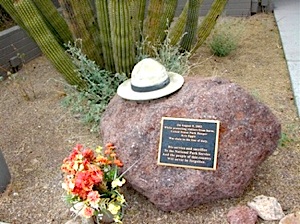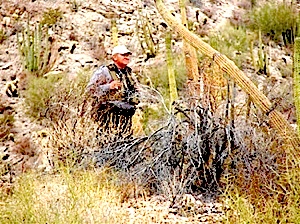Editor's note: One of the most trampled units of the National Park System is Organ Pipe Cactus National Monument in southwestern Arizona, where drug runners, illegal immigrants, and pursuing Border Patrol agents have zigzagged through the monument's wilderness. But, as Organ Pipe officials note in the following article, plans are being made to restore the resource.
The Organ Pipe Cactus Wilderness preserves the natural beauty of an expansive area within the Sonoran Desert Region of North America. Extending over more than 300,000 acres, the Organ Pipe Cactus Wilderness occurs along 30 miles of the international border with Mexico, in a region where high levels of illegal border-related activities have continued for more than a decade. The resulting and complex social, legal, environmental and political issues have largely kept corresponding issues about wilderness under the radar of public debate.
Managing this vast conservation area on the border frequently requires federal agencies to work together to balance the needs of both national security and wilderness.

A monument stands to Kris Eggle, a park ranger who was murdered by drug runners in the park in 2002. Lee Dalton photo.
Such efforts are exemplified by a 2006 Memorandum of Understanding among the U.S. Departments of Agriculture, Interior and Homeland Security. This agreement authorizes border enforcement agents to drive off-road in wilderness under exigent or emergency circumstances that involve threats to human health and safety.
Since the MOU took effect, monitoring data have shown that off-road-vehicle impacts have increased and today the agencies generally agree that there are opportunities for improvement.
Unquestionably, the high levels of illegal activity along the entire border need to be addressed. The U.S. Border Patrol, NPS and other law enforcement agencies work hard daily to do just that. They need our unwavering support and cooperation as they perform their mission.
The NPS has demonstrated this by supporting national security initiatives in and around Organ Pipe Cactus National Monument, including: joint border enforcement operations; the construction of a vehicle barrier and pedestrian fence, and the establishment of a network of high-tech surveillance towers. Considerable other security infrastructure exists and still more is proposed.
The unprecedented level of border-related activity has made managing the Organ Pipe Cactus wilderness challenging. Today, the effects of these activities are visible throughout the monument. We have documented thousands of miles of unauthorized roads and trails. We also deal with trash, graffiti, abandoned vehicles, vandalism, invasive plants and animals, altered ecological processes and degraded habitats.

Border Patrol agents patrol the park. Lee Dalton photo.
Similar to other conservation areas, our wilderness also shows the effects of other stressors on the environment, like climate change. We spend considerable time trying to understand the cumulative effects of border-related activity, and other stressors, on wilderness character, threatened and endangered species, geological and ecological processes, cultural resources, and visitor enjoyment. The results of this work are already helping us develop and implement a variety of educational, prevention, and resource restoration programs.
The demanding nature of this work sometimes causes us to wonder how wilderness matters here, today. Despite the challenges, opportunities do still exist here to experience true wilderness - untrammeled, natural and undeveloped. Organ Pipe Cactus National Monument remains an internationally recognized example of successful conservation in the Sonoran Desert. In 1976, the United Nations Educational, Scientific and Cultural Organization (UNESCO) designated the monument as a biosphere reserve, one of only about 500 in more than 100 countries.
The monument's mountains, bajadas, valleys and washes continue to support unique communities of Sonoran Desert life. The critically endangered Sonoran pronghorn, with a U.S. population of only about 100 animals, is still here, thanks to the expansiveness of this wilderness along with the numerous and coordinated recovery actions of diverse partners.
The endangered lesser long-nosed bat continues to thrive here, able to reproduce successfully by foraging among the monument's abundant and uninhabited forests of columnar cacti. Quitobaquito, a critically important desert spring and pond system that lies within a stone's throw of the Mexican border, continues to support uniquely adapted plants and animals, including the endangered Quitobaquito pupfish.
History has shown that the Organ Pipe Cactus wilderness can recover from transformative land uses. Not so long ago, ranching and mining were prominent across this landscape. Although still visible, their marks are receding and after more than 30 years of "rest" from such activity, wilderness character continues to improve. We hope for similar recovery of wilderness character one day from the current and prolonged effects of border-related activity.
Until then, we encourage wilderness managers and advocates everywhere to become familiar with what is happening here. Unprecedented issues continue to unfold and much can be learned or lost. A visit here can be instructive and enlightening, and we welcome your questions and comments about our challenges.
The National Wilderness Preservation System embodies our national values. Dedicating vast areas to remain as they have always been - wild and undisturbed, for the world to experience and enjoy - was certainly visionary. The architects of the Wilderness Act never said it would be easy, however. We owe them the accolade of our best efforts, especially in times like these.


 Support Essential Coverage of Essential Places
Support Essential Coverage of Essential Places







Comments
The attacks on ORPI's wilderness by Cong. Rob Bishop are just one small part of his declared war on federal land ownership -- and especially wilderness -- in the west. Bishop won't be satisfied until all federal land either has an oil well on it or has been privatized and handed off to ownership by powerful development interests. (I know that's a bit of an exaggeration, but it's not a big one.)
By cloaking his hatred for wilderness and parks in the paranoia of Homeland Security, he sees what he hopes will be a way to succeed in this by arousing the wrath of gullible ultra-conservatives against what he frequently calls Federal Land Grabs.
The truth, according to several rangers, Border patrolmen, and a member of Arizona's Department of Public Safety with whom I spoke early last year, is that it's actually easier to apprehend illegals within wilderness areas than on private lands. That's because when electronic monitors pick up movement, they can be reasonably sure it's illegal. It's not necessary to try to sort out the illegal from legal activities such as a rancher herding cattle or plowing a field. Once movement has been detected, it's a fairly easy job to simply monitor it until the subjects reach a road where they can be nabbed without entering the wilderness with machinery. They told me there is a much higher success rate because of wilderness.
So, Lee, what you are saying is to allow the drug and human smugglers to freely mix with the citizens that might like to experience our Wilderness and not intercept the illegal activity until they reach I-10 or would it just be more environmental friendly and less confrontational to just make I-40 our Southern Border? Protect our borders or we're doomed and part of the what could be described as the possible coming "Liberals Regret."
We visited OPC NM in May 2010 - one of the most remarkable parks we've seen so far. A visit is strongly recommended. On Ajo Mountain Drive the only other car around was a border patrol vehicle. Such true loneliness is hard to find nowadays even in NPS sites.
Anon, you are adding things to my comment that aren't there, nor were intended to be there. It's that kind of rhetorical distortion that makes sensible discussions virtually impossible these days. What I was pointing out is the fact that there are many other ways of solving the problem without destroying the wilderness.
How about suggesting some solutions, instead?
Lee: Appears to me your points of discussion were very clear and I responded in kind. "Destroying the Wilderness" or protecting the borders seems to be the choice you present. Sounds like with your approach the only people fully utilizing Organ Pipe NM would be the illegals who I'm pretty sure wouldn't be particularly inclined to obey park regulations concerning any number of areas including the safety of NPS Rangers. Okay, reason not ideology.